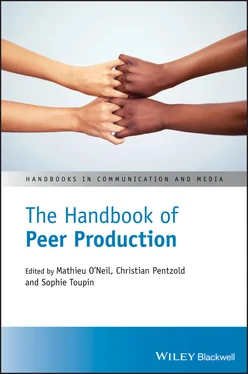9 Casilli, A. (2017). Digital labor studies go global: Toward a digital decolonial turn. International Journal of Communication, 11, 3934–3954.
10 Corradetti, C. (2017). Constructivism in cosmopolitan law: Kant’s right to visit. Global Constitutionalism, 6(3), 412–441.
11 Crumley, C. L. (1979). Three locational models: An epistemological assessment for anthropology and archaeology. In M. B. Schiffer (Ed.), Advances in archaeological method and theory (pp. 141–173). New York, NY: Academic Press.
12 Crumley, C. L. (2015). Heterachy. In R. Scott & S. Kosslyn (Eds.), Emerging trends in the social and behavioral sciences (pp. 1–15). New York, NY: Wiley.
13 Dahlander, L., & Magnussonn, M. (2008). How do firms make use of open source communities?. Long Range Planning, 41(6), 629–649.
14 Elliott, M. (2006). Stigmergic collaboration: The evolution of group work. M/C Journal: A Journal of Media and Culture, 9(2). http://journal.media‐culture.org.au/0605/03‐elliott.php
15 Galloway, A. (2004). Protocol: How control exists after decentralization. Cambridge, MA: MIT Press.
16 Giotitsas, C. (2019). Open source agriculture: Grassroots technology in the digital era. Basingstoke: Palgrave Macmillan.
17 Foucault, M. (1977). Discipline and punish: The birth of the prison. New York: Pantheon Books.
18 Freeman, J. (1970). The tyranny of structurelessness. Berkeley Journal of Sociology, 17, 151–165.
19 Kelly, M. (2012). Owning our future: The emerging ownership revolution – journeys to a generative economy. Oakland, CA: Berrett‐Koehler Publishers.
20 Kostakis, V. (2010). Identifying and understanding the problems of Wikipedia’s peer governance. First Monday, 15(3). Retrieved from http://firstmonday.org/htbin/cgiwrap/bin/ojs/index.php/fm/article/view/2613/2479
21 Kostakis, V., & Bauwens, M. (2019). How to create a thriving global commons economy? The Next System Project. Retrieved from https://thenextsystem.org/learn/stories/how‐create‐thriving‐global‐commons‐economy
22 Kostakis, V., Latoufis, K., Liarokapis, M., & Bauwens, M. (2018). The convergence of digital commons with local manufacturing from a degrowth perspective: Two illustrative cases. Journal of Cleaner Production, 197(2), 1684–1693.
23 Marsh, L., & Onof, C. (2007). Stigmergic epistemology, stigmergic cognition. Cognitive Systems Research, 9(1–2), 136–149.
24 Marx, K., & Engels, F. (1848). Manifesto of the communist party. New York, NY: International.
25 O’ Mahony, S., & Bechky, B. (2008). Boundary organizations: Enabling collaboration among unexpected allies. Administrative Science Quarterly, 53(3), 422–459.
26 O’Neil, M. (2010). Shirky and Sanger, or the costs of crowdsourcing. Journal of Science Communication, 9(1). Retrieved from https://jcom.sissa.it/archive/09/01/Jcom0901%282010%29C01/Jcom0901%282010%29C04
27 Ostrom, E. (1990). Governing the commons: The evolution of institutions for collective action. Cambridge: Cambridge University Press.
28 Ramos, J. (2016). Cosmo‐localism and the futures of material production. Retrieved from http://actionforesight.net/cosmo‐localism‐and‐the‐futures‐of‐material‐production/
29 Reagle, J. (2010). Good faith collaboration: The culture of Wikipedia. Cambridge, MA: MIT Press.
30 Reagle, J. (2013). “Free as in sexist?” Free culture and the gender gap. First Monday, 18(1). Retrieved from https://firstmonday.org/article/view/4291/3381
31 Scholz, T. (2012). Digital labor: The Internet as playground and factory. New York, NY: Routledge.
32 Scholz, T., & Schneider, N. (2016). Ours to hack and to own: The rise of platform cooperativism, a new vision for the future of work and a fairer Internet. New York: OR books.
33 Starosielski, N. (2015). The undersea network. London: Duke University Press.
34 Taylor, R. (2010). Kant’s political religion: The transparency of perpetual peace and the highest good. Review of Politics, 72(1), 1–24.
35 van Steen, M., & Tanenbaum, A. (2016). A brief introduction to distributed systems. Computing, 98(10), 967–1009.
36 Wales, J. (2014). Transcript: Jimmy Wales. Aljazeera. Retrieved from https://www.aljazeera.com/programmes/headtohead/2014/04/transcript‐jimmy‐wales‐201446143728879415.html
37 Wark, M. (2004). A hacker manifesto. Cambridge, MA: Harvard University Press.
1 1Although in theory peer production has a high degree of openness, in practice fewer women and people of color (especially from the Global South) are part of peer production. There are several “cultural” barriers that prevent people from joining. Patriarchy and racism are two flagrant examples. For instance, see Reagle (2010) regarding Wikipedia’s barriers to genuine openness, and Reagle (2013) for the gender gap within free and open source software.
3 Political Economy of Peer Production
Benjamin J. Birkinbine
Understanding the political economy of peer production requires consideration of at least two interrelated factors: the economic factors that enabled the rise of peer production and the unique cultural factors within peer production communities that have the potential to subvert the prevailing tendencies of global capitalism. The economic factors can be found in the broader structural changes occurring within capitalism throughout the 20th century, particularly after World War II and in the run‐up to the Vietnam War era when global geopolitics was being reshaped by a wave of independence movements in the Global South as well as increased war expenditures in the United States. All of these factors set the stage for a response to the economic crisis of 1970s. It was during this time that capital responded to the long downturn by searching for new opportunities for boosting profitability (Brenner, 2006). On the one hand, these changes had dramatic effects on labor processes, commodity supply chains, and manufacturing practices, all of which became increasingly networked to maximize efficiencies and reduce excess capacity.
On the other hand, these changes – and especially the rise of computers and networked communication systems – enabled greater interconnection between people who could collaborate with one another to produce collectively governed resources. As such, there were contradictory forces at play in the increasingly networked global economy. Networking capabilities not only began to transform labor processes across the globe, but simultaneously allowed for production that was no longer driven by market demands. Communities of peers connected by networked communication technologies began producing informational or digital commons, which were made freely available to others. Benkler (2006) framed this type of production as commons‐based peer production , which he defined as “a new modality of organizing production: radically decentralized, collaborative, and nonproprietary; based on sharing resources and outputs among widely distributed, loosely connected individuals who cooperate with each other without relying on either market signals or managerial commands” (p. 60). For example, the free and open source software movement provides an exemplary case of what commons‐based peer production enables, in that it was driven by an ethos of sharing and a strong belief in productive freedom (Coleman, 2013). This community, as well as other communities of commoners around the world, challenged longstanding assumptions in economics about competition, self‐interest, and the maximization of individual profit. Indeed, these communities challenged fundamental definitions of value , including what it meant and how it circulated within communities.
This chapter considers the political economy of peer production by contextualizing the rise of peer production within capitalism and evaluating to what extent peer production contradicts, or reinforces, these global economic trends. To that end, I begin by tracing the structural changes of capitalism in the 20th century that provide the economic foundation upon which peer production arose. Accompanying these changes was also a shift toward more flexible work routines that privileged creativity, autonomy, and innovation. I argue that the roots of peer production lie in these transformations. Finally, I discuss some more recent scholarship about how value is created and circulates within commons‐based peer production communities and discuss how these circuits of commons value intersect with capital accumulation circuits. One of the pressing questions running throughout this discussion is whether this emergent value system has the potential to bring about a postcapitalist future, in which the values of care, trust, mutual aid, and conviviality are prioritized rather than capital accumulation.
Читать дальше


![О Генри - Справочник Гименея [The Handbook of Hymen]](/books/407356/o-genri-spravochnik-gimeneya-the-handbook-of-hymen-thumb.webp)









